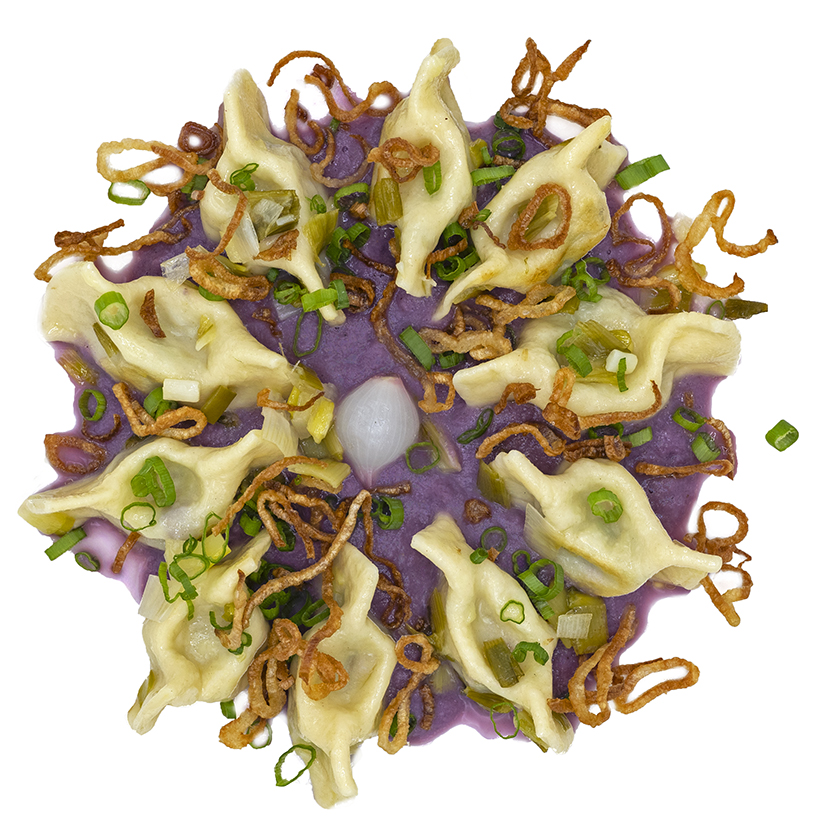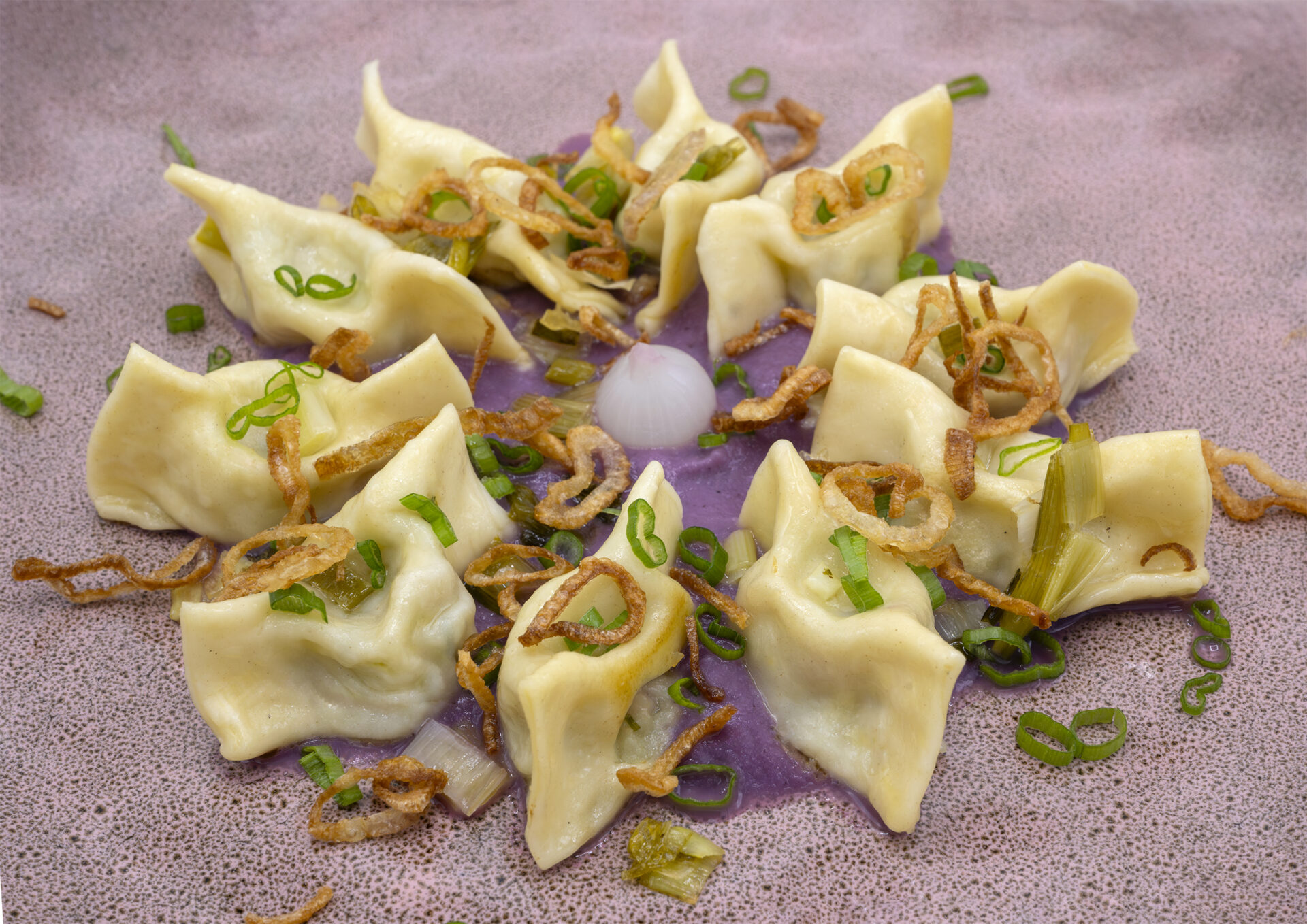In the hinterland of the Slovenian coast, the town of Idrija is (relatively) known for two things: its mercury mine, and its žlikrofi, bicorne-hat-shaped ravioli stuffed with a mixture of mashed potatoes and bacon. Idrijski žlikrofi have become one of the most popular dishes in Slovenia, and the first in the country to obtain the European status of Guaranteed Traditional Specialty, in 2010. And the Brussels bureaucracy offers a gold mine for the researcher-gastronome: in over a dozen sections and subsections, the registration application (available online) provides the history, recipe, and method of preparation, detailed with the erratic precision of the civil servant, sometimes specifying the dimensions of each ravioli to the millimeter, sometimes stipulating that the aroma of authentic žlikrofi must be “intense and typical.”
Yet the origin of the žlikrofi remains obscure. In Naš idrijski kot [Our Corner of Idrija] (1936), Božič Lado states that they come in different types, served on holidays, with potato, meat, or pickled turnip, served with pork cracklings or a butter sauce. In Fond Doprinos k zgodovini Idrije [Contribution Fund for the History of Idrija] (1956), Karl Bezek writes that žlikrofi resemble Viennese Schlickkrapferl, dumplings with onions and smoked meat (the Slovenian and German words actually don’t sound very different). According to rather vague accounts reported by Bezek, žlikrofi were introduced from Central Europe at the beginning of the 19th century, and they could be bought ready-made in the streets around 1840. Nowadays, they are almost always prepared with potatoes, onions, and bacon, served on their own, sprinkled with breadcrumbs, or as an accompaniment to meat.
My own žlikrofi, although intense in flavor, are quite atypical. Their dimensions do not respect the specifications of the Guaranteed Traditional Specialty registration, and my ingredients are fanciful (I add grated cheese, for example). I serve them with several textures of onion vaguely inspired by one of the dishes I tasted at Strelec restaurant in Ljubljana: a purée of red onions with blackcurrant, pearl onions in vinegar, fried shallots (so good that you’ll want to make extra), sliced spring onions… The pencil pushers in Brussels would be enraged.
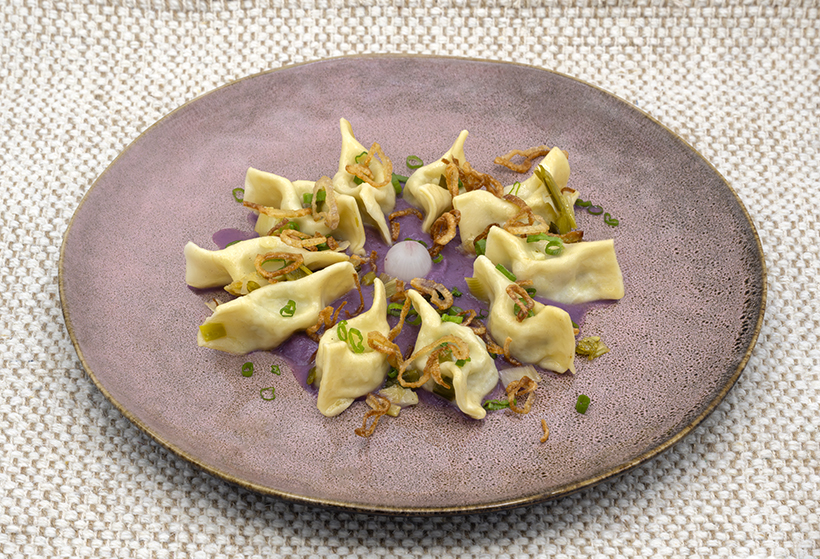
Slovenian Žlikrofi and Onion Textures
Yields 4 servings
Total preparation: 4 hours 30 minutes
Active preparation: 3 hour 30 minutes
Onion-blackcurrant purée
1 whole large red onion (about 300 g), skin on
65 g heavy cream
5.5 g blackcurrant powder
1.5 g salt
0.2 g black pepper, ground
- Place the red onion in an oven dish, and bake in a 200 C / 400 F oven for 1 to 1 ¼ hours, to an internal temperature of 95 C / 200 F. Let cool for 5 minutes.
- Peel the onion and discard the skin; you should have about 240 g of flesh. Coarsely chop, and transfer to a blender. Add the cream and blackcurrant powder, season with salt and pepper, then process until smooth. Pass the purée through a chinois, transfer to a plastic container, and reserve.
- The purée can be kept in the refrigerator for a couple days.
Fried shallots
180 g peeled shallots
1.5 kg canola oil, for deep-frying
salt
- Line a baking sheet with 2 layers of paper towels. Prepare a strainer over a heat-resistant bowl.
- Cut the shallots into slices 2-3 mm thick, separating the rings.
- Combine the shallots and oil in a pot tall enough to keep at least 10 cm clear at the top. Cook over high heat, stirring frequently, until the shallots begin to bubble, 2-3 minutes.
- Continue cooking, stirring constantly to ensure even cooking, until the shallots turn golden brown, 8-10 minutes.
- Working quickly but safely, pour the contents of the pot into the strainer. Transfer the shallots to the baking sheet, spreading them out into an even layer, and season with salt. After a minute, remove the upper layer of paper towels, rolling the shallots onto the second layer. Cover with another layer of clean paper towels, and let cool.
- You should have about 50 g of fried shallots. You can store them for a few days at room temperature, in an airtight container lined with paper towels. The used oil can be kept in the refrigerator for another use.
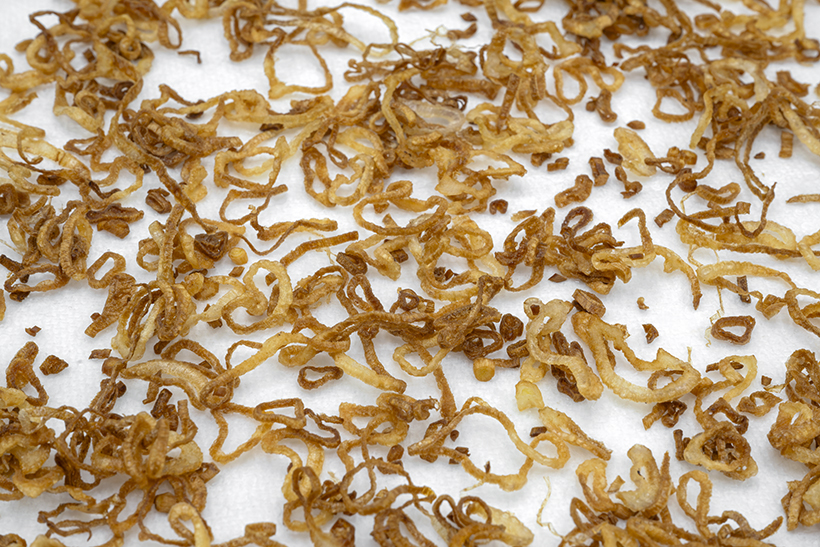
Butter-poached scallions
120 g peeled scallion whites, whole
70 g butter
3 g salt
- Place the scallions, butter, and salt into a sous-vide pouch. Vacuum-seal, and cook in a 85 C / 185 F water bath for 1 hour.
- Let cool and reserve in the pouch. The scallions can be kept in the refrigerator for a day.
Žlikrofi dough
155 g AP flour
2 g salt
50 g (about 1) egg
45 g milk
- Place the flour, salt, egg, and milk in the bowl of an electric mixer fitted with the paddle attachment. Mix on low speed for 4 minutes.
- Shape the dough into a ball, wrap in plastic, and let rest at room temperature for at least 30 minutes.



Žlikrofi
170 g peeled Yukon Gold potatoes, halved
salt
35 g bacon, fine brunoise
30 g peeled shallot, fine brunoise
35 g grated gruyère
4.5 g chives, sliced
black pepper, ground
10 g (about 1) egg yolk
20 g water
žlikrofi dough
AP flour, for dusting
- Place the potatoes in a saucepan filled with salted water, bring to a simmer, then cook over medium heat until tender, about 20 minutes.
- Meanwhile, sauté the bacon in a small saucepan over medium-high heat until it starts to brown. Add the shallot, and cook on medium heat until soft. Reserve.
- Drain the potatoes in a colander, let steam for a minute, then purée using a food mill fitted with the finest disk. Mix in the gruyère, then the bacon and shallot. Let cool to room temperature.
- Add the chives to the potato mixture, and season generously with salt and pepper. Portion into 40 balls, roughly 1-1.5 cm in diameter and 5 to 5.5 g each.
- Mix the egg yolk and water in a small bowl to make an egg wash.
- Roll the žlikrofi dough to the second thinnest setting using a pasta machine, dusting your work surface with flour as needed. Cut the dough into 4 sheets.
- Cut each sheet of dough into strips 6 cm wide. Adjust the length based on the dimensions of your sheets – strips of 24 cm x 6 cm will fit five ravioli, strips of 14 cm x 6 cm will fit three.
- Proceed one strip at a time, keeping the rest of the dough covered with plastic wrap. Place the strip on a board, long edge towards you, and brush with egg wash. Arrange balls of potato filling 1/2 cm from the bottom edge, about 3 cm apart. Fold the dough over and press down to seal, then cut into separate ravioli. Proceeding one ravioli at a time, seal the bottom, hold it seam side down, pinch the edges to form little ears, and press the top with a knuckle or a fingertip to make an impression.
- Transfer to a baking tray lined with parchment paper. Repeat with the remaining dough and filling until you have 40 žlikrofi. Cover with plastic wrap until you’re ready to proceed with assembly.
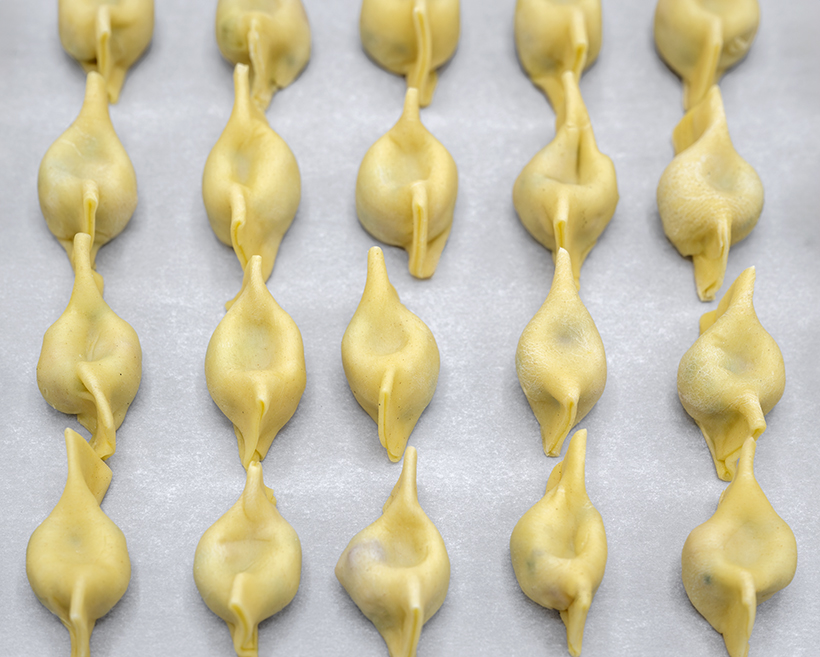
Assembly
butter-poached scallions
žlikrofi
salt
onion-blackcurrant purée
4 pickled silverskin onions
about 25 g fried shallots
about 10 g scallion greens, thinly sliced
- Take the scallions out of the sous-vide pouch, and cut into slices. Reheat in a large pan over medium heat with the butter from the pouch. Reserve.
- Cook the žlikrofi in boiling salted water until the dough is soft. Drain, add to the pan with the scallions, toss with a spatula for a minute, and reserve.
- Reheat the onion-blackcurrant purée in the microwave.
- Rinse the pickled onions under cold water and drain on paper towels.
- On each plate, form a bed of onion-blackcurrant purée, and arrange 10 žlikrofi in a radial pattern, with a pickled onion in the center. Sprinkle with the remaining sauteéed scallions from the pan, fried shallots, and scallion greens.
